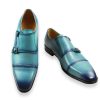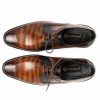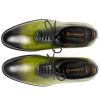A $50 shoe worn 50 times costs $1 per wear. A $500 handcrafted shoe worn 1,000 times costs $0.50. Which is truly the bargain?”
This simple equation cuts through the immediate sticker shock of quality footwear, revealing the core principle of the Quality & Investment Pillar: True value lies not in the initial price, but in the enduring return over a product’s lifespan. When it comes to shoes, handcrafted quality isn’t a luxury expense; it’s a strategic investment yielding dividends in durability, comfort, health, and timeless style. Let’s break down the equation.
The Cost Breakdown: Built to Last (and Last Again)
The foundation of the value equation is superior materials and construction. Compare:
-
Materials: Fast-fashion shoes often rely on thin, “corrected grain” leather (sanded and coated to hide imperfections) or synthetic uppers prone to cracking. Handcrafted shoes typically use full-grain or top-grain calfskin – thicker, more resilient, and developing a beautiful patina. Soles? Synthetic or plastic vs. durable leather, natural rubber, or stacked leather heels.
-
Construction: The critical difference lies beneath the surface. Cemented construction (gluing the sole directly to the upper) is common in cheaper shoes. When the sole wears out or glue fails (often prematurely), repair is difficult or impossible – the shoe is trash. Conversely, welted construction (Goodyear, Norwegian, Blake) stitches the upper to a rib, which is then stitched to the sole. This creates:
-
Superior Durability: The stitching is far stronger than glue over time.
-
Essential Repairability: When soles wear down (which they inevitably do, even on the best shoes), a cobbler can easily remove the old sole and stitch on a new one, effectively giving the shoe a new lease on life – often multiple times over.
-
Cobbler data consistently shows welted shoes have dramatically lower failure rates and significantly longer potential lifespans (often decades) compared to cemented alternatives. The initial investment buys decades of service through repeated repairs, drastically lowering the cost per wear.
The Hidden Value: An Investment in Your Foundation (Your Feet)
The value proposition extends far beyond mere longevity. Handcrafted shoes offer profound benefits for your most valuable assets: your feet and overall well-being.
-
Fit & Support: Mass-produced shoes use generic, average lasts (foot molds). Handcrafted shoemakers, especially those offering customization or multiple last shapes, prioritize anatomical correctness. Features like proper arch support, adequate toe box width (allowing toes to splay naturally), and secure heel counters are fundamental.
-
Material Benefits: High-quality leather breathes, wicking moisture and regulating temperature, reducing the risk of fungal infections and discomfort. It also molds gently to your foot over time, enhancing personalized comfort.
-
Long-Term Health: Podiatrists emphasize the critical role of proper footwear. Ill-fitting, unsupportive shoes contribute to a cascade of problems: plantar fasciitis, bunions, hammertoes, knee pain, and back issues. The ergonomic design and support inherent in well-made shoes reduce fatigue, minimize blisters, and help maintain proper alignment, potentially preventing costly medical interventions down the line. This isn’t just comfort; it’s preventative healthcare.
The Practical Angle: Calculate Your Own Cost Per Wear
The proof is in your own closet. Try this:
-
Track: For a pair of typical fast-fashion shoes, note how many wears you get before they show significant wear, become uncomfortable, or fall apart. Track the initial cost.
-
Compare: For a pair of quality handcrafted shoes, track the initial cost plus any repair costs (e.g., a heel top lift or full resole). Track the number of wears over years – likely far exceeding the cheaper pair.
-
Calculate:
-
Fast-Fashion: Cost / Total Wears = Cost Per Wear (Often $1-$5+)
-
Handcrafted: (Initial Cost + Repair Costs) / Total Wears = Cost Per Wear (Often drops below $0.50 over time)
-
-
Consider: Factor in the avoided cost of repeatedly replacing cheap shoes and the potential savings on foot-related healthcare.
The Investment Verdict: Appreciating Assets
The math is compelling, but the true value of the Quality & Investment Pillar transcends pure economics. Handcrafted shoes represent an investment in:
-
Durability: Decades of reliable service.
-
Comfort & Health: Reduced fatigue and potential long-term musculoskeletal benefits.
-
Timeless Style: Classic designs crafted from premium materials that look better with age, avoiding fleeting trends.
-
Sustainability: Significantly reduced waste compared to the disposable cycle of fast fashion.
-
Pride of Ownership: The knowledge and satisfaction of wearing something made with skill and care.
Conclusion
That $500 handcrafted shoe isn’t just a purchase; it’s a cornerstone of the Quality & Investment Pillar. When viewed through the lens of cost per wear, long-term health benefits, repairability, and enduring style, the initial price transforms into remarkable value. Handcrafted shoes aren’t an expense; they’re an appreciating asset for your feet, your wallet, and your wardrobe. They are built not just to be worn, but to be lived in – and lived in well, for a very long time. Choose wisely, invest once, and walk confidently into the future.












